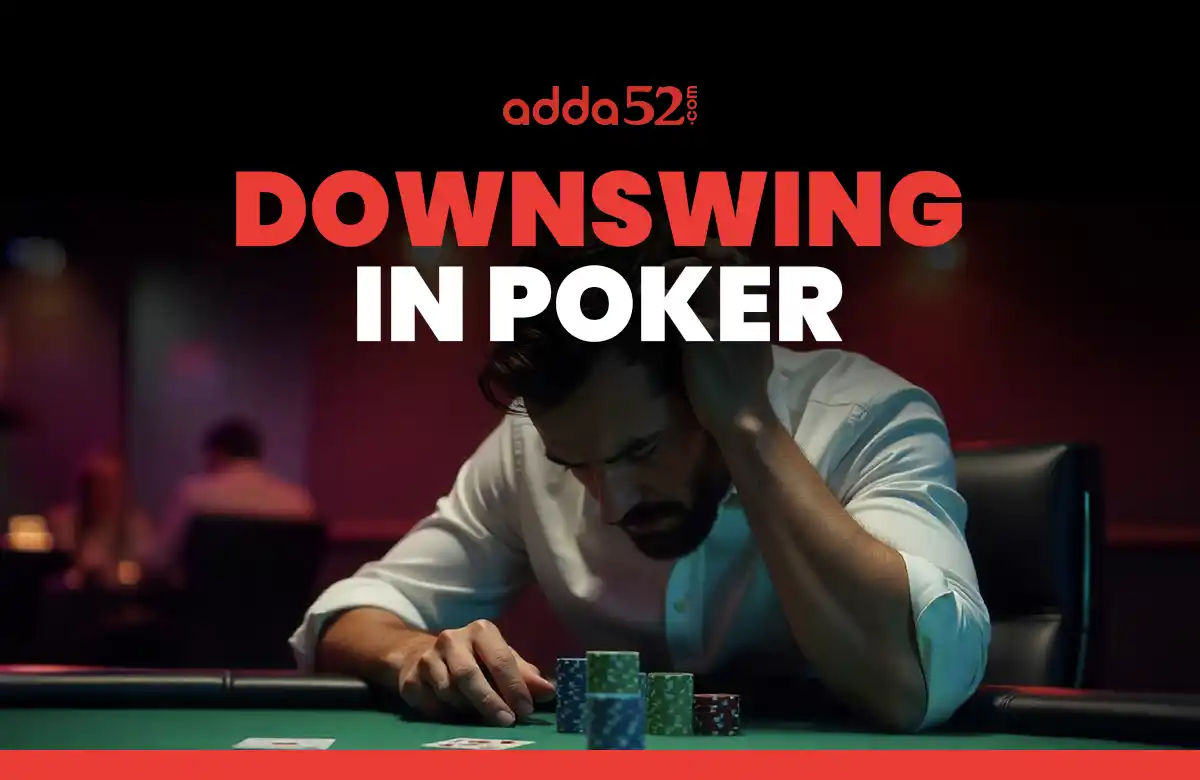
Introduction
A downswing in Poker is a reality that every player must face at some point. No matter how skilled you are, there will be sessions where nothing seems to go your way.
The key to long-term success isn’t avoiding downswings but learning to handle them. This guide will help you understand a downswing, why it happens, and, most importantly, how to recover and emerge stronger.
Understanding Downswing in Poker
A downswing is a prolonged period of losses that occur due to variance. Unlike a single unlucky hand or session, a downswing lasts over multiple sessions, sometimes weeks or months. The key characteristic of a downswing is that you are losing despite making good strategic decisions. You might be playing the same way you always have, yet the results aren’t in your favour.
What is Variance in Poker?
Variance is the mathematical measure of fluctuations in Poker results. Even with an edge, your short-term results can vary greatly due to the randomness of the cards.
A cash game player with a 5 BB/100 win rate (winning 5 big blinds per 100 hands) will still have losing months due to variance.
Because of the top-heavy payout structure, a tournament player with a 50% ROI will still experience 100+ buy-in downswings.
Variance doesn’t care how good you are. Even the best players can go on losing streaks.
Causes of Downswings
A. Natural Variance
Variance causes short-term fluctuations in results, even for highly skilled players. For example, if you go all-in preflop with KK against QQ, you will win around 82% of the time. However, the 18% chance of losing will still happen, and sometimes it can happen multiple times.
B. Bad Beats & Coolers
A bad beat happens when you get all your chips in with the best hand, only for your opponent to hit an unlikely draw. Conversely, a cooler is a situation where two strong hands collide, but one is slightly stronger. These scenarios contribute to downswings, leading to losses even when you play correctly.
C. Mental Game Issues & Tilt
One of the biggest dangers of a downswing Poker situation is that it can affect your mental game. Tilt refers to emotional decision-making caused by frustration, leading you to play hands poorly. During a downswing, players often start second-guessing themselves, making desperate bluffs, calling in spots they usually wouldn’t, or playing overly tight out of fear of losing more money.
D. Leaks in Your Game
While variance is a major factor in downswings, sometimes it exposes weaknesses in your play. If you consistently lose, it’s worth reviewing your hands to see if you are making mistakes you weren’t aware of. Common leaks include playing too many hands, calling too often instead of folding, bluffing in the wrong spots, or failing to adjust to different opponents.
E. Poor Bankroll Management
Proper bankroll management is crucial for surviving downswings. If you are playing with a bankroll that is too small, even a standard downswing can wipe out your entire roll. A common rule of thumb is to have at least 30-50 buy-ins for cash games and 100-200 buy-ins for tournaments. This ensures that even if you go on a long losing streak, you still have enough funds to continue playing at your preferred stakes.
How Likely Is a Downswing?
Here’s how often a downswing occurs:
Example: Downswing Probability for Cash Game Players
- Win Rate: 5 BB/100
- Standard Deviation: 100 BB/100
- Sample Size: 100,000 hands
Here’s the probability of downswings:
|
Downswing (Buy-ins) |
Chance Over 100,000 Hands |
|---|---|
|
10 Buy-ins |
~60% |
|
20 Buy-ins |
~25% |
|
30 Buy-ins |
~10% |
|
50+ Buy-ins |
~5% |
Example: Downswing Probability for Tournament Players
Tournament variance is much higher because one big score can make or break your results.
|
ROI |
50 Buy-in Downswing |
100 Buy-in Downswing |
200 Buy-in Downswing |
|---|---|---|---|
|
100% |
~10% |
~5% |
<1% |
|
50% |
~25% |
~15% |
~5% |
|
20% |
~50% |
~30% |
~15% |
|
10% |
~75% |
~50% |
~30% |
Even the best players will experience deep downswings in tournaments. That’s why proper bankroll management is critical.
How Long Does a Downswing Last?
The length of a downswing depends on:
Your win rate – Higher win rates recover faster.
Your volume – More hands/tournaments help you get back on track.
Your mental strength – Avoiding tilt prevents further losses.
Formula to Estimate Recovery Time
Recovery Hands = Downswing Size (BB)/Win Rate (BB/100) × 100
Example:
- You have a 5 BB/100 win rate.
- You are down 20 buy-ins, which is 2000 BB (assuming 100 BB per buy-in).
- Expected hands to recover = (2000 / 5) × 100 = 40,000 hands.
It could take 40,000 hands to fully recover from a 20-buy-in downswing. But if variance is bad, it could take even longer.
How to Overcome a Poker Downswing
Manage Your Bankroll Wisely
A solid bankroll is your safety net during downswings. If you are on a prolonged losing streak, move down in stakes to reduce financial pressure and regain confidence. A conservative bankroll management strategy—such as 50-100 buy-ins for cash games or 100+ buy-ins for tournaments—helps you withstand variance.
Control Tilt and Maintain a Strong Mindset
Tilt can worsen a downswing, leading to irrational decisions and further losses. Recognizing tilt and taking action—such as stepping away from the tables when frustrated—can prevent additional damage. Accept that variance is part of the game and focus on making the best possible decisions rather than being results-oriented. Meditation, exercise, and a sound support system can help maintain a healthy mindset during tough times.
Continue Learning and Improving
Use the downswing as an opportunity to study more. Watch training videos, read poker strategy books, and discuss hands with experienced players to refine your skills. Improving your knowledge helps you make better decisions and boosts your confidence. Working on both technical and psychological aspects of the game ensures long-term success.
Put in Volume, But Play Smart
While increasing your volume can help smooth out variance, playing too much when you are mentally exhausted can be counterproductive. Focus on playing quality sessions rather than grinding to chase losses. Take breaks when needed and return with a fresh perspective to avoid making emotional decisions.
Stay Positive and Trust the Process
Every poker player, even a professional, experiences downswings. The key is to remain patient and trust in your ability to make profitable decisions over the long run. Keeping a positive attitude, maintaining good habits, and continuing to improve will ensure that you are ready to capitalise on when variance swings back in your favour.
Frequently Asked Questions
What is a downswing in Poker?
A downswing is when a player experiences losses despite making correct decisions. Every Poker player, regardless of skill, will experience downswings due to the game's random nature. How long a downswing lasts depends on factors like your win rate, bankroll management, and emotional control.
Does bad play always cause a downswing?
No, a downswing isn’t always caused by foul play. While poor play can contribute to losses, downswings often result from bad beats and coolers. Properly managing your bankroll and staying mentally strong are key to navigating these periods.
How to avoid going on tilt during a downswing?
To avoid going on tilt during a downswing, take regular breaks to reset your mind. Practice mindfulness, stick to your bankroll management strategy, and focus on making good decisions instead of chasing losses. Maintaining a clear mindset and trust in your long-term strategy is essential rather than being swayed by short-term results.
Conclusion
A downswing is inevitable in every Poker player’s journey, regardless of skill level. While it can feel frustrating and disheartening, it’s essential to remember that variance is a natural aspect of the game. Understanding and managing this effectively will allow you to weather the storm and become a better player.
